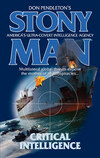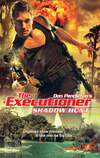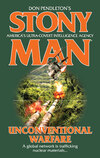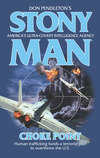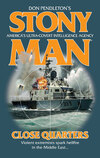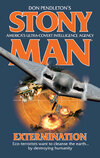Kitabı oku: «Critical Intelligence», sayfa 2
CHAPTER TWO
Bogotá, Colombia
Lieutenant Colonel Sim Sin-Bok lit his cigar.
The North Korean intelligence officer narrowed his eyes in pleasure as he inhaled the thick, strong smoke of the Corona Grande. The rich nicotine entered his bloodstream and he immediately felt the euphoric rush. He relaxed into the plush leather seats of the BMW X3 and released the tobacco smoke through his nose in a sigh.
“Nothing but the best, eh, my friend?” Jimenez Naranjo purred.
The FARC commander was seated directly across from the covert representative of North Korea. The two men rode in comfort as the sleek, black BMW SUV flew down a jungle road leading deeper into mountains.
“I must admit,” Sin-Bok said in accented Spanish, “I have come to enjoy our little liaisons.”
“Your boss, he enjoys our money, too. No?” Naranjo winked, flashing white teeth.
“As much as yours enjoys our armaments,” Sin-Bok countered.
The intelligence officer had been all over the Pacific Rim and Middle East in his years of service with the most glorious leaders. He had come to have a grudging respect for the FARC commander Naranjo in the course of their dealings, but weapons sales to violent groups always left him feeling nonplussed at best.
The SUV raced along the jungle road, cutting deeper into the mountain stronghold of the last nebulous Communist insurgency left on the planet. More than any ideological revelations, it had been the extortion of Colombian drug barons by the FARC guerrillas that had propelled them down a road toward the sort of capitalism they claimed to despise so much. They claimed their actions were about the rights of the peasant farmers to grow a crop that turned them profits and improved their lives.
For all Sin-Bok knew, the FARC leaders believed that. But he also knew that the influx of cocaine money had made things like up-armored diplomat-model BMW SUVs available to what had once been a rabble force dressed in rags. They were also able to purchase guidance systems such as the ones he carried on a flash drive in his briefcase. Guidance systems that could turn shoot-and-forget munitions such as old Soviet S-7 grail rocket launchers into weapons of pinpoint accuracy, capable of disabling a tank or knocking even American combat helicopters out of the sky.
Naranjo moved his hand down and hit a lever button on his seat rest. Behind him the vehicle’s glass partition powered smoothly up, the engine making a subdued whine as it closed.
Sin-Bok kept his face inscrutable. He had dealt with Chinese Tongs based in Hong Kong, with representatives of Hamas and the Syrian government. He had sold or bought illicit goods from them all. He did not rattle easily and best of all, his ability to eat outside of the famine pit that was North Korea had left him with a bit of a pot belly. Such a belly was an indication of power in his nation. Men noticed and feared those grown so powerful they could be fat. Women took note and were appropriately impressed.
Sin-Bok cocked an eyebrow toward Naranjo.
When the FARC leader spoke he carefully enunciated each word so that there could be no misunderstanding. And he spoke in English.
“Two plus five equals seven,” he said.
Sin-Bok felt a cold squirt of adrenaline hit his stomach. He felt his throat swell up from the reaction and he forced himself not to swallow and thus reveal his surprise and nervousness.
By the dragon’s luck, he thought wildly, this cannot be. Then he thought, Their servants truly are everywhere.
On his lap his hands tightened momentarily around his attaché case. Then relaxed. He met Naranjo’s eye and nodded once, sharply.
“Three plus four equals seven,” Sin-Bok replied, also in English, completing the code parole and establishing his rank as one higher than his contact.
The two agents of the shadowy organization stared at each other for a long moment. Naranjo opened a lid set between his rear-facing seats and pulled out two cut-crystal tumblers and a bottle of expensive rum.
He poured Sin-Bok a glass and handed it over. The North Korean espionage agent took it without a word. The enhanced suspension on the BMW made their vehicle ride like it was on rails. He sipped the sugar-cane liquor, enjoying the sharp alcohol.
He carefully set his tumbler on top of his leather attaché case and picked up his cigar from the ashtray. He drew in a lungful of smoke as the FARC narcoterrorist and field agent poured himself a drink.
After Naranjo had put the bottle away, Sin-Bok spoke again.
“I take it these guidance systems aren’t just headed for your jungle camps,” he observed.
“Ah, no,” Naranjo admitted, switching back to Spanish. “I, like you, am a link.”
With a rueful look Sin-Bok held up his glass. “Here’s to Seven,” he said, voice rueful.
White House, Washington, D.C.
HAL BROGNOLA LOOKED OUT the east door of the Oval Office and into the Rose Garden. Beside him in a comfortable chair sat the special envoy to North Korea. They faced the President of the United States in his traditional seat behind the desk made from the timbers of the HMS Resolute.
Behind them in the northeast corner a grandfather clock built by John and Thomas Seymour ticked out the passing of time. Waiting for the President to finish reading the report, Brognola looked down at the carpet on the floor, noting the presidential seal. He’d been in this office a good many times over the years, seen more than one man pass through the job, seen the job age them all.
The President sighed. He tossed the national intelligence estimate addendum down on the desk and leaned back. He folded his hands in a pensive motion and cocked an eyebrow at Brognola.
“You’re sure, then?” The question was perfunctory.
Brognola nodded once. “Yes, sir.”
The President frowned and twisted slightly in his seat. “Let’s get ’em on the line,” he told the envoy.
The special envoy leaned forward and tapped a few numbers out on the handset located on the desktop. He activated the speakerphone function and leaned back while the number dialed. After two digital ring tones a smooth feminine voice answered, Korean.
The envoy answered in Korean, then stated, “With your permission, Mr. Ambassador, I would like to switch to English.”
There was a brief pause, then a sharp, almost shrill man’s voice spoke in quick, truncated syllables. The North Korean regime did not maintain a diplomatic presence in the United States, and the men in the Oval Office were speaking to the leader of the U.N. delegation in New York.
“Yes, English is fine,” the ambassador said. “But whatever language we choose to continue wasting our time in, the fact still remains constant. The Democratic People’s Republic of Korea has no knowledge of the activities of which you speak. We consider such activities as a personal insult on the character of our most beloved leader, the eternal president, Kim Jong-il. Frankly a continuation of this so-called investigation will be construed as a hostile act.”
Brognola shifted his gaze away from the conference call toward the President’s face. It remained impassive except for the slight tightening of muscles along the jaw, indicating that he was grinding his teeth.
“Mr. Ambassador,” the envoy began, “we consider the arming and training of known terrorist groups such as FARC to be hostile acts.”
“Fortunately for the United States, Korea has not undertaken any of these activities.”
“Why is that ‘fortunate’ for us?” Brognola interjected.
“Because,” the voice continued, “if such an error in perception was to occur, the United States might be tempted to do something rash in response.”
“I trust you’ve read the dossier I sent you earlier,” the envoy prompted.
At his desk the President made a steeple of his long, slender fingers and leaned slightly forward in his chair. He was due to a staff meeting to discuss implementation of public health care options in twelve minutes. Brognola could see the President growing more annoyed with the futile game they were now playing with the North Koreans.
“I have seen the dossier,” the ambassador admitted. “I saw nothing compelling in those documents. The idea that a member of our security services would be working as a trainer and liaison for a FARC cell in Colombia is obviously impossible. That leaves only two explanations for your report that I can see.”
The envoy let out a sigh and leaned back in his chair. “And those explanations would be…?”
“Either your much vaunted intelligence services are mistaken or, second and more likely, you are attempt to fabricate this evidence to justify a preemptive strike on our homeland.” The ambassador paused, then began speaking in a much louder, much shriller voice. “This is inexcusable! We will not be the victim of your imperialist plots! We will defend our home by any means necessary from your Western aggression!”
The President looked over at Brognola. He silently mouthed the word imperialist to the big federal agent. Brognola shrugged, then murmured under his breath, “They’re a little like Cuba,” he explained. “Forty or fifty years behind. They probably just got a copy of Dr. Strangelove in Pyongyang last month.”
The President made a sour face as the ambassador continued to bark his outrage over the conference link. He made a chopping motion with one hand toward the phone, then nodded at the envoy.
“Mr. Ambassador,” the envoy interrupted, “your protests have been noted. We will not be speaking of this matter again. Good day.” He cut the connection.
“Okay,” the President said. “I gave it one last try. We don’t know what kind of brinksmanship they’re trying to pull off this time, but they can go to hell.” He spun around in his chair and looked out at the Rose Garden. “Your boys in position to execute our contingency plan?”
“It seems our contingency just upgraded to primary,” Brognola said. “And yes, my crews are in place and ready to roll.”
“Then proceed,” the President said.
Once they left the office Brognola and the special envoy went in separate directions, each man pulling out a NSA-encrypted cell phone. The director of the Justice Department’s Sensitive Operations Group hit the number 1 on his speed dial option. Two rings later Barbara Price answered.
“I just got out of my meeting with the Man,” he informed her. “We are ready to execute.”
Stony Man Farm
BARBARA PRICE STOOD in the hallway in front of the door leading to the Communications Room. She said goodbye to Brognola and cut the connection on her phone before opening the door.
Price entered the room like a gust of wind. The attractive mission controller wore a headset communications link and carried a matte-black cell phone PDA with NSA security upgrades.
She walked across the room, nodding to where Akira Tokaido and Carmen Delahunt sat at workstations. A giant flat screen was fixed to the wall above their heads. The monitor was silent and still, for the moment showing only the screen saver: an image of the movie poster for The Magnificent Seven with the quote from the script, “We deal in lead, friend.”
“Time?” Price asked.
“M-Minute minus twenty seconds,” Kurtzman replied.
From the other side of the room he used a blunt, square-tipped finger to toggle his wheelchair away from his workstation. The electric engine of the power chair ramped up as the leader of the Stony Man cybernetics team pulled even with Stony Man’s mission controller.
“Okay,” Price said. “Bring central synchronistic communications online.”
At her station, Carmen Delahunt typed a command on her keyboard. Inside Price’s headset earjack, the receiver popped and the ex-NSA operational manager nodded once to Delahunt.
“Stony Base to Stony Eagle,” she said. “Radio check, over.”
Instantly the voice of Stony Man pilot Jack Grimaldi answered, coming over the digital link with crystal clarity. “Base, this is Bird,” he replied. “I have good copy.”
Price gave a curt nod to herself and turned toward the communal HD screen and pointed a finger.
Kurtzman tapped a command on an interface board built into his power chair and the screen switched to a satellite image of the Earth. The observation platform was a Keyhole satellite in near-Earth geosynchronous orbit completely dedicated to the needs of Stony Man operational taskings.
“Stony Base to Stony Hawk,” she continued.
“Stony Hawk, good copy,” Able Team leader Carl Lyons answered in clipped syllables.
On the screen the sat image rotated until the HD monitor showed the Western Hemisphere. Kurtzman tapped out a few clicks on his keypad, centering the screen over Central America, and then began to tighten its resolution as it slid down toward the southern continent. Kurtzman hit another command key and a political map was overlaid on the topographical features.
“Do you have eyes on target?” Price asked.
“Affirmative,” Lyons responded.
“Eagle, give us your position,” Price told Grimaldi.
“I’m in a holding pattern behind Hill 372, about three klicks out,” Grimaldi said.
On the overhead monitor the political map showed Colombia. The spy camera tightened its resolution even further and suddenly the POV began descending at a rapid rate.
To the onlookers it seemed as if they were in the nose of a plane as it dive-bombed through wispy patches of clouds toward the earth below.
“Hawk and Eagle, we are green light go,” Price said. “I repeat, we are green light go.”
“Copy,” Grimaldi answered.
“Copy,” Lyons said.
Price looked to the wall. On one side of the image, scrolling vertically were GPS coordinates blinking rapidly next to numerical sets of longitude and latitude readings.
Patches of green and brown, at first unidentifiable, formed into a jungle canopy over a series of rolling hills. On the southeast side of the screen a broad, fast-moving river cut through the trees. Up the sheer plateau from the water, a brown dirt road cut out of the rugged geography.
From his position at his workstation Akira Tokaido manipulated the sat image. The camera view settled on a flat area of the map. At first the location appeared to be nothing more than dense brush where the road ended.
“Toggling to IR,” Tokaido informed the room.
His thumb struck the appropriate key and instantly the crystal-clear picture on the screen changed to a swirling mesh of colors based on radiant heat that made the monitor appear like a watercolor canvas.
On the screen the figures beneath camouflage netting showed up immediately. Roughly two dozen individuals moved around, spread over an area the size of a soccer field.
Several bright spots indicated where industrial furnaces were active and in one section of the field several large vehicles sat clustered in parallel rows. Cool rectangular blobs revealed Quonset huts and long, narrow buildings of concrete and wood.
The tension in the room grew as they waited for the field teams to strike. Barbara Price leaned forward and grabbed the backrest on an office chair. She squeezed it hard until her knuckles shone white from her grip.
Then, on the screen, all hell broke loose.
CHAPTER THREE
Colombia
Carl Lyons lifted his Bushnell binoculars and scanned the FARC camp below. Able Team’s position was located right above the only road leading into the terrorist outpost. This was a hammer-and-anvil operation, with Able Team serving as the anvil.
The readout on the range finder built into the optics showed 204 meters. Sweat trickled down Lyons’s body, sliding over his feverish skin to collect at his armpits, navel and groin. He was a big man and heavily muscled, which made the heat a burden to him. He was growing crankier by the second.
Behind him in the brush Hermann “Gadgets” Schwarz slapped a mosquito. The Able Team electronics genius was crouched next to a 80 mm mortar. Lined up in front of the squat weapon’s base plate were six rounds: two high explosive, two antipersonnel, two white phosphorous. He lowered a compass and quickly adjusted the angle of the tube based on his reading.
On the ground a tripod-mounted electronic device hummed softly. The size of a Power-Book it had an antenna dish set in the top that slowly rotated. On loan from the Pentagon through the DARPA—Defense Advance Research and Projects Agency—program, the XM-12 was a field-portable scrambler unit capable of disrupting digital signals in addition to radio waves.
Out in front of Schwarz and Lyons the third member of Able Team lay belly-down on the soggy ground. Ex-Special Forces sergeant Rosario Blancanales had his right eye suctioned up close against the rubber cup of his sniper scope.
“You heard the lady,” he growled. “Let’s do this thing.”
“Phoenix inbound,” Grimaldi informed them over the com link. “Adios, assholes,” Blancanales muttered to the narcoterrorists. Behind him Schwarz picked up the first HE round.
In the reticule of his scope the Puerto Rican’s crosshairs were settled on a bearded FARC soldier manning the machine gun position at the entrance to the camp.
The man wore dark khaki fatigues stained with sweat. His tangle of long, greasy black hair was kept back by a shapeless black beret, and he wore a 9 mm Browning Hi-Power in a belt holster opposite the sheath for a wicked-looking machete.
He laughed, and blunt, very white teeth stood out like neon against his walnut-brown complexion. On his web gear he carried a sat phone, which had first alerted Blancanales that this was a leader. Two other soldiers, much younger and beardless, stood around listening to the older man talk, M-16 A-2 assault rifles in their hands.
Blancanales slowly released his breath and felt his world narrow to the crosshairs of his scope. The FARC leader’s fatigue shirt was open to the belly, revealing an expanse of curly black hair across his lean chest. A gold chain hung down between the man’s pectoral muscles. Blancanales’s crosshairs centered there.
From the valley there was the sudden sound of an approaching helicopter. The man snapped his head around at the noise. The M-21 sniper rifle with folding paratrooper stock coughed once as Blancanales squeezed the trigger in a slow, controlled movement.
Across two hundred yards he saw the FARC leader jerk as the 7.62 mm NATO round struck him. In the sniper optic Blancanales saw blood halo out behind the man in a fine mist. The target half spun, crumpled to his knees, then fell forward on his face.
The two sentries standing next to the dead man swept up their weapons. They turned toward the sound of the helicopter, spun back toward the road from where Blancanales’s round had come. They brought their M-16s to their shoulders and started shouting in Spanish.
Lyons opened up with his cut-down M-60E.
He had the machine gun supported on a fallen log and fed from a green plastic, 200-round drum magazine. The weapon roared to life with a stuttering thunder as hot shell casings arced out of the receiver and spun to the forest floor.
The earth in front of the FARC sentries erupted in a series of geyser spouts as he walked his fire in on them. Behind him Schwarz released his hold on the mortar round, dropping it smoothly into the tube. It went off with a throaty bloop. Lyons’s rounds struck the two men.
The heavy-caliber bullets buzzed into the FARC sentries, hacking them up like spinning axes. They spun and jiggled like marionettes dancing for a puppeteer. They staggered, dropping their weapons, then flopped to the ground still quivering.
Schwarz’s 80 mm HE mortar round struck the camp dead center of the FARC motor pool. A black Ford Excursion with its roof cut off and massively oversize tires exploded. A ball of black smoke and orange flame mushroomed out. The vehicle was picked up off the ground and spun end-over-end, crumpling an old school bus repainted OD-green. Two five-ton Oso-12 trucks had their windows blown out, and a FARC soldier walking past was picked up and thrown like a rag doll.
Blancanales drew down on a running soldier and pulled his trigger. The man fell in a tangled heap.
Lyons eased up on his machine gun and activated his throat mike.
“Eagle, this is Hawk,” he said. “The front door is sealed. Deploy.”
“Copy,” the British-accented voice of David McCarter replied.
“Drop the WP right on the road in case anyone tries to drive out,” Lyons told Schwarz.
Schwarz nodded, then twisted the elevation knob on the mortar down several clicks. He lifted a white phosphorous round and dropped it in. The mortar went off and the round lobbed outward in a tight arc. The WP bomb struck the earth at the sentry post and detonated. Instantly the corpses at the impact site burst into flame.
Satisfied, Schwarz dropped his second round on the same angle and turned the entrance to the FARC camp into a raging conflagration.
“Keep an eye out for our Korean guest,” Lyons told Blancanales.
The ex-Green Beret nodded and continued sweeping his scope across the camp below them, hunting for targets of opportunity. Lyons opened up with his M-60E and directed suppressive fire on the FARC compound.
JACK GRIMALDI lifted the Blackhawk straight up out of the shallow jungle valley and bunny-hopped the bird over the hilltop. He put the nose of the helicopter down and raced forward, flying at treetop level. Two hundred yards out, his thumb flicked up the red safety cover to his rocket pod.
The FARC compound had two 20 mm antiaircraft emplacements providing security and they were Grimaldi’s first priority. He banked the bird hard, brought it on line with the narrow, fast-moving creek below and gunned the Blackhawk hard toward the camp.
His thumb depressed the button.
Instantly twin seven-inch rockets from pods under his weapons platform launched toward the camp. The projectiles whistled out, leaving contrails of white smoke behind them as they flew.
They both hit the sandbag walls encircling one of the 20 mm AA cannons and exploded. Gunny sacks, body parts and pieces of the guns went flying. Grimaldi worked his foot pedals and maneuvered the yoke. The Blackhawk banked hard, then spun around on its axis until the nose was orientated 120-degrees on a separate plane.
Through the windshield Grimaldi could see the antiaircraft crew scrambling to bring the 20 mm cannon to bear. Men’s faces twisted in fear and anger as they swarmed like ants around the gun placement. The helicopter remained level under Grimaldi’s hand. Again his thumb found the activation toggle.
Two more rockets leaped from their pods and swept forward, spiraling inward on synchronous flight paths. FARC gunners threw themselves out of the artillery pit in a desperate attempt to avoid the blast, but the twin explosions caught them in a concussive wave of lethal force.
“Here we go!” Grimaldi yelled into his throat mike.
The Blackhawk yawed hard, then settled into a hover fifty yards off the broken, uneven ground. Camouflage netting across the compound was ripped off and tossed into twisted heaps around the aluminum pole frame work, revealing men, sheds and tin-roofed buildings. A cloud of dust sprang up like fog as the topsoil was ripped from the ground by the force of rotor wash.
A thick hemp rope was kicked out of the cargo bay door. An instant later T. J. Hawkins, ex-Delta Force operator, appeared in the doorway. He wore a black sporting helmet and clear visors over his eyes. His hands were covered by thick welder’s gloves.
“Go! Go! Go!” David McCarter shouted.
Instantly, Hawkins stepped off the helicopter and onto the rope, sliding down the hemp weave like a firefighter on a pole. He was halfway down when the second man appeared in the door, then grasped the rope. Rafael Encizo, veteran anti-Castro guerrilla commando and combat diver, stepped off and dropped like a stone.
On the ground Hawkins shuffled forward a few places and took a knee, weapon coming up. Encizo dismounted the rope and took up a position to Hawkins’s left, his own weapon up as Calvin James, former Navy SEAL and trained medic, hit the rope.
Hawkins saw two men in Russian military fatigues run out of an outbuilding, weapons up. He drew down on them and used his M-4 carbine to cut them down.
Beside him Encizo unleashed his own firepower, an M-249 Squad Automatic Weapon, in stuttering bursts.
James hit the ground, bending at the knees to absorb the force of the impact, and a second later Gary Manning, former Canadian Special Forces soldier and explosives expert, also landed. The Canadian put his own M-60E in the pocket of his shoulder and fired over the heads of his teammates as he shuffled forward.
James peeled off to Encizo’s left, forming the anchor point on one end of their wedge formation as Manning shuffled into position on the opposite side. Behind them McCarter was on the ground, his M-4/M-203 combination carbine grenade launcher up and tracking for targets.
“Clear!” McCarter shouted.
The ex-SAS trooper walked smoothly forward, weapon up and finger on the trigger. Behind him the assault rope was disengaged by the helicopter loadmaster and door gunner, a sergeant from the 75th Ranger Division on loan to Stony Man’s blacksuit security detail.
“Copy!” Grimaldi responded.
The helicopter’s turbine engines screamed as the pilot climbed the bird up to a better altitude. The loadmaster/door gunner slid over behind an M-134 Gatling gun and rotated the barrel cluster around to bear on the compound.
“Advance,” McCarter directed.
Instantly the unit began shuffling forward, firing their weapons as they moved. Above them the Blackhawk drifted along, the 7.62 mm minigun firing ahead of them. The weapon’s massive rate of fire had twinkling, smoking hot shell casings dropping down on them like metal raindrops.
In front of them FARC soldiers tried desperately to mount a defense, but the triple impact of speed of attack, aggression of action and firepower coupled with surprise was proving more than they could deal with. FARC guerrillas soaked up bullets like sponges, were scythed in two or battered into submission.
Hawkins walked his muzzle in measured angles from left to right, dropping running, screaming targets with each squeeze of his trigger. Encizo used his SAW from the hip, triggering one short burst after the other. He saw a door to a long, low barracks-style building swing open and he took it under fire immediately. Red tracer fire arced through the opening and dropped a knot of FARC guerrillas.
“Able, do we have eyes on?” McCarter demanded through his com set. Beside him Manning used his M-60E to blast into an armored sedan being used as cover by a handful of enemy combatants.
“Negative,” Lyons replied. “To your five o’clock I have the command bunker.”
McCarter looked in the direction Lyons had indicated and, as if to punctuate the ex-cop’s directions, Schwarz put an 80 mm mortar round down on top of a jet-black armored BMW SUV parked near a concrete structure. The luxury sport vehicle went up like a Roman candle. A moment later another mortar went off.
“I have eyes on bunker,” McCarter answered. Beside him Gary Manning mowed down three FARC soldiers attempting to set up an RPK machine gun.
“Good,” Lyons replied. “Blancanales said he scoped our target entering the bunker twenty minutes ago.”
“En route,” McCarter confirmed.
Machine-gun fire erupted from just ahead and to the left of them. Bullets cut toward the assault force in a lethal wave. The concussive force of the heavy-caliber rounds cutting through the air next to their bodies buffeted Phoenix Force and they all went down in defensive sprawls.
“Machine gun, left!” Encizo called out.
The team looked toward the position and saw a reinforced foxhole with a sandbag roof. A .30-caliber machine gun burped out another burst as the gunner tried to find his range.
Manning, armed with his own machine gun, cut loose, trying to suppress the other gunner’s fire. His bullets gouged up furrows of earth just in front of the position and slapped into the dirt-filled sandbags, causing the FARC machine gunner to flinch.
Encizo lifted the barrel of his SAW and added to the maelstrom of fire.
McCarter used the barrage as cover enough to risk popping up to one knee. He tucked the butt of his M-4 into his shoulder and triggered his M-203 attachment. A 40 mm fléchette round shot from the barrel and arched like football into the enemy position.
A heavy bang sounded and smoke began roiling. Razor-sharp fléchette darts scissored into the machine gunner and his assistant, cutting the men to bloody ribbons.
Phoenix rose as one unit, weapons up. Manning stepped forward and unleashed the M-60E in a wide arc in front of them, spraying the camp in a crescent-moon pattern designed to keep other defenders from gaining momentum.
“Bunker!” McCarter yelled. “Gary and Rafe, cover!”
The two machine gunners ran forward and threw themselves down to give themselves overlapping fields of fire. Behind them the other three members of Phoenix Force prepared to storm the bunker.
